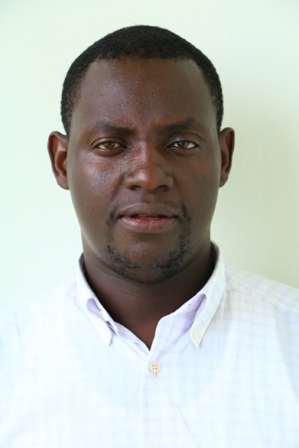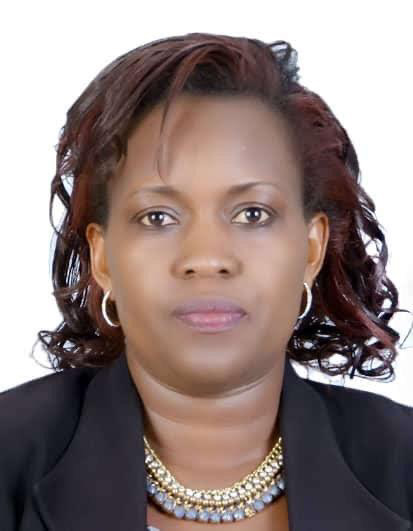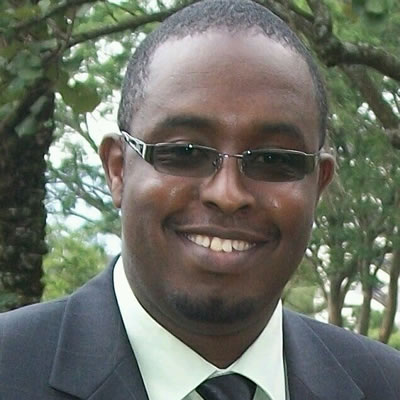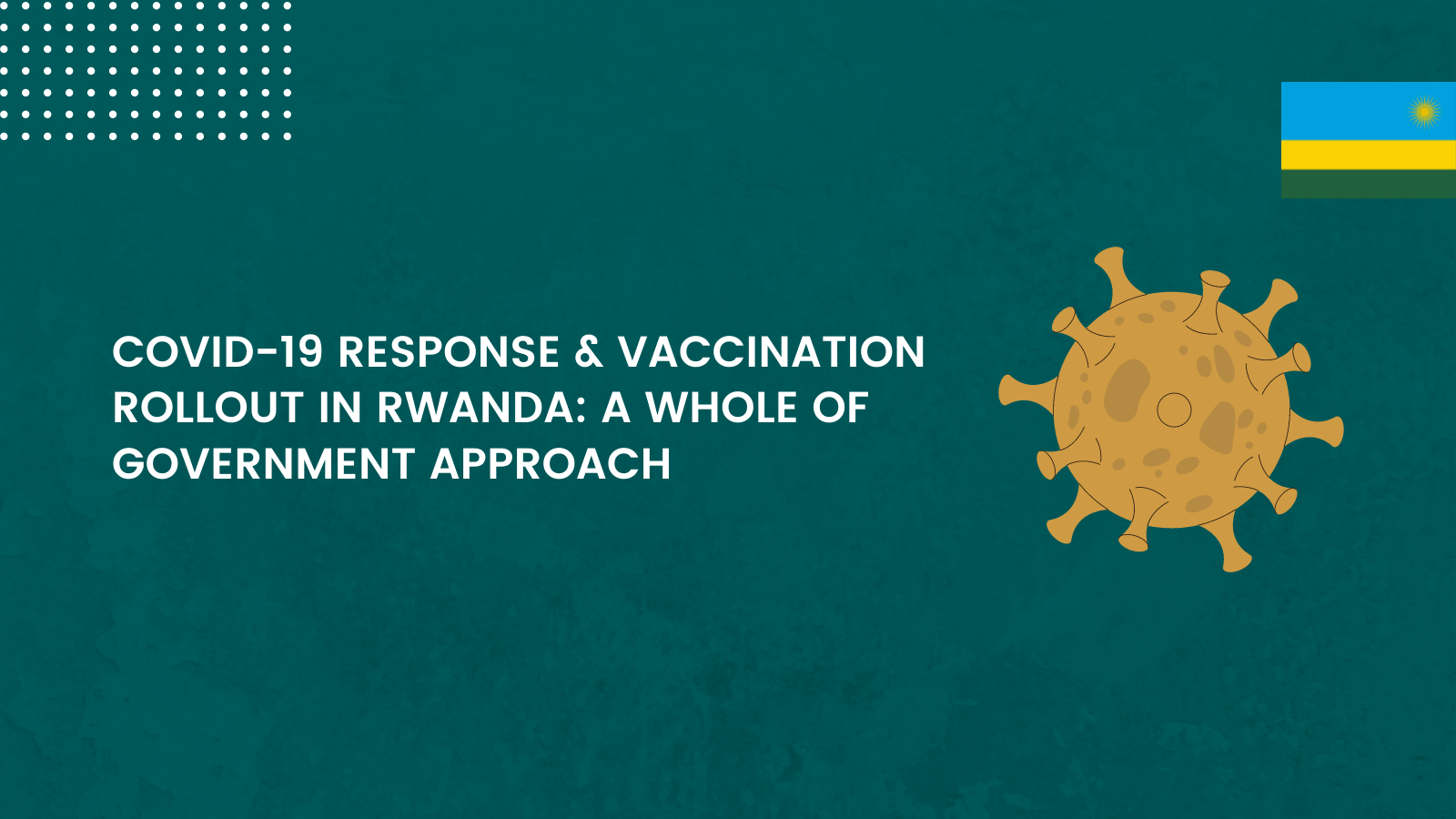Introduction
Rwanda is an East African country of about 12 million people, with 83% living in rural areas. Rwanda’s whole-of-Government approach was instrumental in the COVID-19 pandemic response and rolling out the COVID-19 vaccination plan across the country. Rwanda’s Ministry of Health reported the country’s first case of COVID-19on 14th March 2020. Despite the Government of Rwanda’s strategy and efforts to contain the virus and mitigate the pandemic’s short- and long-term consequences, the number of cases continued to increase. The COVID-19 pandemic has disrupted the country’s economy and affected the socio-economic well-being of its citizens. However, the Government of Rwanda (GOR) has capitalized on Ebola preparedness experience to establish a country-owned surveillance and outbreak system, develop preparedness capacity and strengthen the national health system to prevent and control epidemics and other public health emergencies and threats. This blog highlights the successes and lessons learnt in Rwanda in the ongoing response to the COVID-19 pandemic.
Key enabling factors
In Rwanda, the success of the approach depended on two key enabling factors: leadership and collaboration. The Office of the Prime Minister leads the national COVID-19 response under the National Epidemic Preparedness and Response Coordination Committee (NEPRCC) along with the Ministry of Health (MOH), the Ministry of Local Government (MINALOC) and Security organs. The Government of Rwanda (GOR) activated the National Epidemic Preparedness and Response Coordination Committee (NEPRCC), which appointed the COVID-19 National Steering Committee (NSC) to oversee the coordination of the Joint Task Force activities (see Figure 1 in appendix). The Rwanda Biomedical Centre (RBC) and the MOH are the nation’s central health implementation agencies and have been primarily involved in developing the National COVID-19 Preparedness and Response Plans. The NSC has contributed to the successful implementation of the response. The NSC provides general oversight and strategic guidance for implementing the national response plan and is supported by the Scientific Advisory Group composed of various technical experts in the same field. The COVID-19 National Joint Taskforce activities are grouped into four domains of interventions: epidemiology operations, administrative and logistics communication, and planning units. The cabinet meetings have decided on comprehensive public health measures and resource mobilization and allocation based on real-time data and scientific evidence. This political leadership has enhanced the whole of Government mechanisms during this pandemic and helped shape the national response in partnership with other sectors. It is important to note that the Government approach goes beyond the central government agencies and ministries.
Under the leadership of the Districts Mayors, similar structures were established in all 30 districts, including the. District Command Post and Rapid Response Teams (RRTs) were activated at district levels, reporting daily activities to the central level. These decentralized and inclusive structures generated local evidence, communicating with the public, and ensuring health directives. Local authorities have strengthened community engagement to build trust and ownership and tackle misinformation and rumours about the virus and vaccines. Regular risk communication, briefings with the media and information updates were provided to keep the public informed and reduce panic and anxiety. The engagement of different stakeholders, including community and local authorities, remains strong and well-coordinated. Performance contracts were useful to set context-specific targets, and accountability mechanisms were rigorously applied at all levels.
Whole of Government Response in Case Management and Treatment
During each pandemic response stage, stakeholders contributed to disease control efforts and played a vital role in continuous quality improvement processes and activities. The GoR, in collaboration with its stakeholders, developed Standard Operating Procedures (SOPs) and a national work plan in the COVID-19 National Preparedness and Response Plan and case management guidelines for COVID-19. Health services were decentralized, and COVID-19 services were provided subsidized by the Government at the early stages of the pandemic. The COVID-19 response worked within the existing healthcare system and focused on a sub-set of critical interventions and services. The Ministry of Health selected the treatment and isolation centers based on the quality of infrastructure and capacity in terms of equipment. All public hospitals were equipped with ambulances for transportation of suspected cases to designated COVID-19 treatment centers. Community health workers were trained and given appropriate equipment to follow up patients who were not in critical condition with home-based care.
The benefits package was expanded to ensure that all health insurance schemes in Rwanda cover the health services related to COVID-19 treatment and diagnosis. The benefits package was expanded to cover COVID-19 related consultation, laboratory diagnosis and tests, medicine, counselling and hospitalization. However, the voluntary covid-19 test cost is not included in the services provided by the health insurance companies. The move was in line with the Government’s decision to integrate COVID-19 management within the existing health system. Other innovative strategies included remote case identification, use of a toll-free hotline, dissemination of appropriate information on COVID-19 symptoms and strategies for prevention through drones, use of robots for screening, storing medical records, sanitizing hospitals and distribution of foods and medicines for patients in isolation rooms. These drones were used for communication or delivery of medical products, including lifesaving blood supplies.
Whole of Government Response in Resource Mobilization and Allocation
The GoR adopted a more practical approach to mobilize additional funds (both domestic and external) to combat the COVID-19 pandemic and support the economic recovery response. These measures included reallocating resources toward humanitarian relief for the most vulnerable, tax deferrals, reallocating additional funding for the health sector, the establishment of economic recovery funds, among others. Fundamental mechanisms included grants and concessional borrowing and bilateral and in-kind financing to support spending on the COVID-19 response. Furthermore, senior Government officials in the public sector have contributed to the COVID-19 support by forfeiting their April 2020 salary as a way of self-reliance. Private sector engagement was also an important strategy to mobilize domestic funding from manufacturers and businesses. The private sector produced Personal Protective Equipment (PPEs), supported people in need of essential goods such as food, and contributed to the transportation and distribution of health commodities and medical supplies.
At the early stages of the pandemic, diverse ministries and agencies came together to address fragmentation, set priorities and coordinate the utilization of available resources and capacities to improve efficiency and effectiveness. The Ministry of Finance and Economic Planning (MINECOFIN) led the implementation of the resource mobilization strategy. This entailed cooperation and collaboration across multiple stakeholders and adjustments of fiscal policies and regulations at national and sub-national levels based on the best available evidence and lessons learnt. For instance, Rwanda reached out to the Pandemic Emergency Financing Facility housed at the World Bank, the International Monetary Fund, and other financing institutions to bridge the financing gap for the COVID-19 response and finance critical interventions. Mobilized resources were invested in healthcare infrastructure, increased ICU bed capacity, purchased supplies, training of health workers, payment of service providers, supply chain management, information and technology (IT) system & digital solutions, risk communication, and community engagement.
All COVID-19 related resources from various sources (e., Government, donors and the private sector) were channeled in one common basket to minimize fragmentation of mobilized resources and strengthen mutual accountability in allocating and using resources. Many donors prioritized direct transfers into Government’s budget to cover budget deficits caused by the crisis. Pooling resources in one basket facilitated quick decisions on reprogramming and reprioritizing funds and adequate resource allocation for agreed-upon priority areas. The GoR had increased flexibility in using funds, and accountability mechanisms were strengthened to ensure that the Government receives value for money for the financial assistance received. A strong emphasis was put on efficient use of public resources and adjustment of public financial management (PFM) rules, including the revision of budget law, formulation of spending plans and modalities, flexibility in the public procurement system, emergency spending measures, and reporting mechanisms to strengthen rapid budget execution while retaining accountability. The Office of Auditor General has undertaken regular audits of the National Steering Committee and National Command Post to ensure compliance to accounting norms, financial regulations, and national laws for the use of public funds. Resources were invested in healthcare infrastructure, purchase of supplies, training health workers, supply chain management, information and technology (IT) system and digital solutions. The combination of efforts across multiple stakeholders was very critical to achieve collective success.
Whole of Government Action and Deployment of the COVID-19 Vaccines
In Rwanda, the whole of government approach was instrumental in rolling out and deploying vaccines across the country. To attain herd immunity, the GOR is committed to following its COVID-19 vaccination policy and reaching 30 percent of its population by the end of 2021 and 60 percent by 2022. The realization of these targets and vaccination strategy requires bold, collective action from all stakeholders including, Governments, development partners, organizations and private sector actors. A national coordination task force was established and composed of multi-disciplinary and multi-agency representatives to ensure alignment of actions, cooperation and coordination across multiple stakeholders at local, country, regional and international levels. Weeks before the arrival of vaccines in the country, members of the Scientific Advisory Group and National Task Force for Covid-19 vaccination met weekly to establish a rollout strategy, identify gaps and mitigate risks in the supply chain and define priority actions for policymakers. From these decisions, activities were organized across ministries, provinces and local Government authorities. The National Task Force for Covid-19 vaccination reports regularly to the Prime Minister Office on the status of planning and delivery. Rwanda improved the cold-chain infrastructure before the rollout, and an inclusive and efficient approach was used in identifying the people most at risk of COVID-19 in all corners of the country. These included essential workers and people most at risk of COVID-19 infection, such as frontline health workers, the elderly, the elected officials, people with co-morbidities or disabilities, teachers, community health workers. Later, people living in crowded conditions such as women and men in uniform, prisoners and refugees were also vaccinated. Local leaders were responsible for identifying eligible people in different villages and ensuring equitable access to COVID-19 vaccines. Currently, all citizens aged 18 years and older are in the priority group for receiving vaccines.
Rwanda leveraged the existing infrastructure for routine immunizations to ensure timely distribution and delivery of the COVID-19 vaccine. It procured additional equipment, such as ultra-low refrigerators and refrigerated vehicles, to ensure the proper storage, transportation and distribution of vaccines in remote areas. Rwanda received vaccines donation under the COVAX mechanism, and these were distributed to all district hospitals, which in turn distributed them to all health centers using trucks and military helicopters for hard-to-reach districts. Mobile text messages were sent to people reminding them to go for the second shot in the nearest health centre or hospital. As a result, Rwanda was able to vaccinate the target priority populations quickly effectively. As of August 17, 2021, over 951,796—representing 7.4% of the total population— have been vaccinated. Available data indicates a high rate of acceptance of the COVID-19 vaccines among Rwandans. This can be partially attributed to the trust in the Government response and active involvement of local leaders, youth volunteers and civil society organizations in the COVID-19 campaigns at the community level to address concerns among hesitant individuals by building trust in vaccine safety and effectiveness through the provision of adequate information regarding the vaccine.
Conclusion
Overall, Rwanda’s health system has demonstrated resilience through its effective COVID-19 response and preparedness measures involving actors from multiple sectors and demonstrated that multisectoral action and strategy is both possible and necessary. The country experienced minimal disruption in the delivery of core healthcare services. In relation to accountability and service provision, the GoR has strengthened accountability mechanisms (regular control, reporting and audits) to ensure transparency in the utilization and allocation of resources. The whole government approach has been at the center of containment and control measures of the disease, contact tracing, treatment of patients and deployment of vaccines at all levels across the country.
As Rwanda illustrates, government action is instrumental in establishing a comprehensive approach to combat the COVID-19 pandemic and vaccine rollout. This approach facilitated a more competent, transparent and accountable process in Rwanda. Mobilized domestic and external resources were effectively allocated to public institutions and private providers, including primary healthcare facilities, to make COVID-19 services accessible and affordable. Several key lessons and implications emerged in this case:
- Effective leadership in Rwanda has created an enabling environment for collaboration.
- Policy dialogue platforms for partnership are critical to establish trust, synergies and ensure mutual accountability.
- Learning from whole of Government approaches is essential to improve multi-sectoral collaboration among stakeholders and inform future strategies.
- Finally, it is vital to establish proactive communication with the public and leverage digital technologies where necessary to facilitate whole of government approaches to succeed.
List of Reference
- Anadolu Agency. Rwanda uses Ebola experience to combat COVID-19. 22 April 2020. https://www.aa.com.tr/en/africa/rwanda-uses-ebola-experience-to-combat-covid-19/1813902. Accessed 10 June 2021.
- Karim N, Jing L, Lee JA, Kharel R, Lubetkin D, Clancy CM, Uwamahoro D, Nahayo E, Biramahire J, Aluisio AR, Ndebwanimana V. Lessons Learned from Rwanda: Innovative Strategies for Prevention and Containment of COVID-19. Ann Glob Health. 2021 Feb 25;87(1):23. doi: 10.5334/aogh.3172. PMID: 33665145; PMCID: PMC7908927.
- Nsanzabaganwa et al. Rwanda COVID-19 Vaccination Program Implementation. Rw. Public Health Bul. 2021. 3 (1): 07-9.
- Rwanda Biomedical Centre. Standard Operating Procedures For Preparedness and Response To Coronavirus Disease (COVID-19) Outbreak [Internet] Available from: https://rbc.gov.rw/fileadmin/user_upload/annoucement/SOP%20for%20preparedness%20and%20response%20to%20Covid-19.pdf
- WHO. WHO applauds Rwanda’s Ebola preparedness efforts. 24 July 2019. https://www.who.int/news/item/24-07-2019-who-applauds-rwanda-s-ebola-preparedness-efforts. Accessed 14 July 2021.
- World Bank. Press release: World Bank Supports Rwanda’s COVID-19 Response. 7 April 2020. https://www.worldbank.org/en/news/press-release/2020/04/07/world-bank-group-supports-rwanda-covid-19-response.
AUTHORS

Alypio Nyandwi is a public health professional with experience in public policy analysis, planning, research, monitoring and evaluation. Alypio has over 15 years of working experience in Rwanda’s health sector, where he has worked with both governments and non-governmental organisations at the international level.

Stella Umuhoza is a lecturer and researcher at the University of Rwanda School of Public Health (UR/SPH) in the Department of Health Policy, Economics and Management. She has over ten years of experience working in public health systems. Currently, she serves as a member of the Community-Based Health Insurance (CBHI) Consultative Group and Health Financing Core Group in Rwanda. Stella recently developed Rwanda’s Health Financing Strategic Plan for 2018-2020 and the Family Planning (FP) investment case. Over the years, she has provided technical assistance to various government institutions and international organizations in developing policy documents and briefing notes to inform decision-making.

Dr Parfait Uwaliraye is the Director-General for Planning, Monitoring and Evaluation and Health Financing at the Ministry of Health in Rwanda, a position he has held since November 2012. Dr Uwaliraye is a medical doctor with a Master’s degree in Public Health. He worked as a Research Assistant, a District Medical Officer and the director of Kibagabaga District Hospital prior to joining the Ministry of Health. He has a particular focus on health policy, planning, health financing, private sector engagement and global health.

Sabine Musange F. is a lecturer and currently head of the Health Policy, Economics and Management department at the School of Public Health, University of Rwanda. With a background in both medicine and global health research, her research interests focus on strengthening health systems in low-resource settings. Previous work includes program evaluation in maternal and child health, health systems and financing. Most of her work has been carried out in low-income settings and she is passionate about women and child’s health and above all about improving population health.

